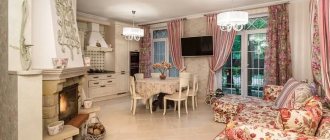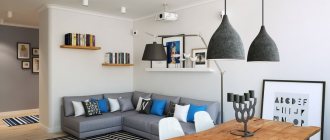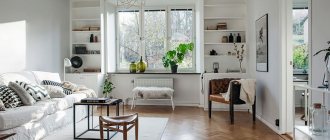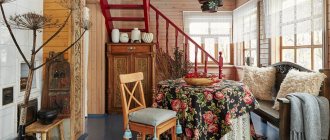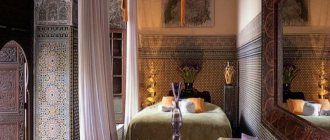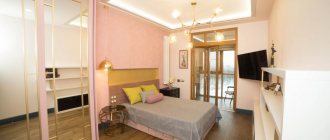A few centuries ago, wealthy residents of European countries decorated individual rooms and entire houses in oriental style. It remains fashionable to this day. Techno, art deco or loft could not supplant this direction, because it is impossible to do so. He has too many admirers and supporters all over the world.
Japanese style doors
Interior in traditional Japanese style
Door in oriental style
Oriental decor in the interior
Oriental style in the interior: characteristic features
The unusual and bright design will appeal to fans of oriental style and those who are tired of boring and monochromatic interiors. I want to fill a spacious and bright room with beautiful furniture, handmade decorative elements, and bright details.
Oriental style in the interior of a living space Source dekormyhome.ru
An abundance of bright colors, designs, patterns, textures, materials fills the interior with harmony and a feeling of homely warmth. Such rooms are associated with a large and friendly family, all members of which love to spend time together. The atmosphere is conducive to lively and positive communication, fun, relaxation, and flights of fancy, which will appeal to creative people.
For all eastern directions, common features can be identified:
- When choosing finishing materials and accessories, you should not limit your imagination and desire to create a rich interior. Expensive materials, beautiful carpets, and gilded lamps are suitable for this. In case of limited material resources, you can choose inexpensive analogues: plastic panels, plain wallpaper, Venetian plaster, tiles, bamboo wallpaper.
- Natural materials are suitable for oriental-style interiors. Expensive and rare types of materials are especially valued.
- The ceiling surface is painted in a light shade. A dark ceiling along with bright wall decoration will reduce the available space. The Chinese style is characterized by the use of wooden beams; in the Arabic interior they create multi-level structures of smooth shapes, decorated with paintings.
- Fabric is important for decorating an oriental interior. Fabric partitions, pillows, blankets, carpets, curtains - all this fills the room with comfort.
- The furniture is simple and proportional; the main attention is paid to decorative elements and textiles.
- Spacious rooms are divided into zones using screens, curtains and partitions.
Oriental style in the interior Source choco.uz
As a result of difficult work, you should get a laconic and functional interior filled with luxury.
Decor options
The choice of certain decorations and decorative elements depends, first of all, on the ethnic option. Middle Eastern style is characterized by the following decor options:
- wood carving or stucco;
- patterned tiles;
- mosaic using bright colors;
- ceramic products;
- painting.
In the process of decorating walls, you can use several types of patterns at once. The carving for the mirror frame, which resembles arches and the ceiling, will be relevant. Ceramics will be an excellent decoration for tables, cabinets and wall shelves.
The Asian version involves the use of decorative elements such as:
- painting walls and panels using various symbols and hieroglyphs;
- artificial fans on the wall;
- various lanterns that hang from a chandelier or ceiling;
- aquariums, small fountains and other sources of water;
- porcelain vases and other similar items.
An excellent way to refresh the interior is to use decorative bonsai trees, which are especially relevant for rooms decorated in Japanese style.
Basic directions of oriental style
Oriental style in the interior is divided into 5 directions.
Features of the Arabic direction:
- dome-shaped;
- smooth lines;
- lack of images of living beings;
- luxury of decoration;
- bright shades.
Bright Arabian interior Source artsten.ru
The leading role is given to natural materials, products made of metal, wood, stone and textiles.
Plastered walls are covered with paint and painting. Since images of living beings are prohibited, landscapes, various buildings, and inscriptions filled with deep meaning are used to decorate walls.
Wall painting in an oriental interior Source yandex.com
To decorate surfaces in oriental style, ornaments are used; in each direction, the color and patterns have their own distinctive features.
The design often features flowers and geometric shapes. Multi-colored mosaics are used for flooring.
Zoning the sleeping and working areas Source comfortoria.ru
The Arabic trend is characterized by an abundance of textiles in everything: the interior is decorated with luxurious carpets, there are many pillows on the sofas, fabric is used instead of partitions, and fabric is also used to decorate the walls.
Arabic design complies with religious requirements and rules. It appeared at the beginning of the 7th century. The fabulous interior was evidence of the selectivity and wealth of the owner.
Bedroom interior in Chinese style Source modernplace.ru
For the Chinese style, many elements made of wood and paper and proportionality of the interior are appropriate. There are other style features:
- natural materials;
- everything reminds of the unity of nature and man;
- the forms are simple and concise;
- there are no sharp corners.
Chinese interiors love simple shapes, wood and bamboo products, and multifunctional furniture is a priority.
Harmonious design in Chinese style Source v-interere.ru
A variety of figurines and fans can be used as decorative elements. The walls and paintings are decorated with drawings depicting plants, birds, and Chinese characters.
Interior of an oriental living room Source ostudio74.ru
A feature of this eastern direction is the simplicity of the design, which looks stylish, modern and harmonious. Bamboo can be used everywhere: for flooring, wall decoration, ceilings. The shoots of this plant are also used to decorate the room, placing them in luxurious porcelain vases.
Decorating a living room in an oriental style Source alldesigngroup.ru
The Moorish direction is a harmonious combination of Arabic, Indian and Egyptian styles. Style Features:
- ceiling structures with vaults;
- furniture finishing with forged metal;
- the color scheme resembles shades of precious stones;
- arches of unusual shape.
Living room in the Moorish style Source rehouz.info
The Moorish interior is associated with the design of a tent; it contains arches, arcades and columns. The basis of this design are European rules for organizing space, symmetry and interior items.
Interior in Moorish style Source uiut.boltai.com
The stylistic direction combines oriental traditions, art features and artistic images. Moorish style design is suitable for spacious rooms.
Decorating a living room in an oriental style Source uiut.boltai.com
The African direction is filled with originality and exoticism, it is characterized by:
- mixing various textures;
- use of bright colors;
- dim lighting;
- energy and dynamism;
- light colored walls.
Bright living room in oriental style Source artsten.ru
African interior attracts attention and reminds a person of his unity with nature; prints of animal skins are often used as decor. Natural forms return man to his roots.
Living room interior Source remont.boltai.com
The Indian direction is characterized by:
- harmony and luxury;
- no clutter of furniture;
- multiple ornaments.
Indian interior Source rehouz.info
Interior items are reminiscent of wealth; they can be decorated with precious stones, ivory, rhinestones and mirror inserts. There are many unusual decorative elements and accessories in the room: Buddha figurines, forged chests, bells.
Features of Indian design Source backbreaker.net
Even elements of national clothing can decorate plain walls.
The Indian oriental style can be described as bright, catchy, and elegant. In such a room there is a festive atmosphere, which helps to improve your mood.
History of origin
The eastern direction has two names:
- Islamic (Muslim). Babylon – The Hanging Gardens of Babylon, which are a real paradise against the backdrop of the desert. In India (7th century), the Taj Mahal was created - the most famous ensemble made in the Muslim style.
- Mauritanian. It arose in the 14th-15th centuries in India based on the Islamic style. The most striking examples of this trend are the Generalife and Alhambri gardens. Their distinctive feature was the appearance of outdoor rooms and “patios” (a composition consisting of courtyards and walls surrounding them).
The style originated in countries that did not have sufficient access to water. Therefore, his characteristic feature was the veneration of this natural element.
Choosing a color palette
Oriental style is associated with the plots of Arabian fairy tales. There will never be a dull moment in such a room. To create a harmonious and stylish interior, it is recommended to use shades of natural colors; their saturation may vary.
Bright interior in oriental style Source dekormyhome.ru
You can use several bright colors in one room, but you shouldn’t overdo it either, otherwise there is a risk of making the interior a smeared spot.
Choosing colors for the interior Source horosho-doma.ru
Accessories
It is the accessories that create a clear feeling that the room belongs to a certain oriental style:
- painted fans, armor and weapons, scrolls with calligraphic inscriptions, engravings, tall porcelain vases, many small details (carved bone figurines, lamps, lamps, boxes) - all this creates Chinese and Japanese styles;
It is the accessories that create a clear feeling that the room belongs to a certain oriental style.
- the Arabian tale is supported by forged elements (fireplace, lamp, shelves, furniture parts), copper and bronze jugs and vases, lamps, mirrors in carved frames, various mosaics;
Japanese painted fan.
- Indian - statues of gods, incense sets, decorative plates, bells, wall panels, vases.
Furniture selection
Furniture for an oriental interior should be functional; for the Arabian style, dark-colored species are suitable; for the Chinese style, bamboo can be used. The shape can be absolutely any, the decoration is carvings, various inserts, and gold plating. Oriental interior is associated with luxury and wealth; there should be little furniture in it; you should not place unnecessary interior items in the living space, which will compress the space and overload the design.
Interior in oriental style Source dizainvfoto.ru
The abundance of textiles and the use of shades of bright colors makes the interior full; the choice of furniture must be approached very carefully; one extra chest of drawers or a bad place for the sofa can disrupt the harmony.
Chinese interiors are often decorated with unique handmade pieces, painted with hieroglyphs, ornaments and patterns.
Unique furniture samples Source tokc.ru
Wooden furniture of simple shape can be turned into a unique and exotic piece, complemented with precious stones and metals, carvings. In most cases, such models are created in a single copy; due to the uniqueness of the design, the furniture has a fairly high cost.
Wooden furniture in an oriental bedroom Source goodfon.ru
Interior examples
The design of residential premises in an oriental style depends on their functional purpose, area and natural light. For spacious rooms in an oriental style, you can use dark shades, which will compress the space in a small room. It is necessary to think through all the details in advance in order to get a beautiful and stylish design of the living space.
Decorating a living room in an oriental style Source happymodern.ru
Living room
The perception of a room depends on the main color scheme. For the living room, you need to take a few bright colors and use them to decorate the interior. Shades of light colors are suitable as a background; they will help highlight bright details.
Living room interior in oriental style Source design-mm.ru
If you plan to gather large groups in the living room, you should take care of the location of people. In this case, you can place a large sofa around the perimeter of the room, and also complement the interior with textiles, arches and tables, and you can lay a carpet on the floor.
Furniture in the living room Source horosho-doma.ru
If family members often gather in the living room, you need to take care of their comfortable presence in this area. To preserve the originality of the oriental style, the TV can be hidden in a special niche. Do not forget about the characteristic decorative elements, furniture and accessories.
Bedroom
Light shades are suitable for an oriental-style bedroom; it is important to maintain a calm and peaceful atmosphere in the room, which will promote rest and relaxation. You should not overload the interior with unnecessary furniture; all pieces should be made of natural materials.
Bedroom decoration Source homeli.ru
An Arabic-style bedroom is filled with wealth; in the center of the room there is a large bed, which can be complemented with canopies, pillows, and a bedspread. Wooden headboard, carved details, inlay, arches, carpets. There is no place for television equipment in such a room; here you need to rest, relax and gain strength.
Oriental bedroom design Source dizain.guru
Popular ways to decorate a ceiling in an oriental style
To finish the ceiling surface in an oriental style, hanging systems are used, to which lamps and decorative elements are attached.
Ceiling structure in the interior of the living room Source vdome.club
Drywall is used to create unusual ceiling structures; this material can be given any shape. The drapery is reminiscent of the ceiling in a tent; for the Asian direction, you can use wood and bamboo. Stretch fabric with ornaments and patterns looks interesting.
Architecture
Eastern architecture is characterized by a combination of several styles. It developed under the influence of religious, cultural, political and social phenomena.
The architecture of medieval Europe was characterized by the Gothic style. Initially, Gothic was used in architecture, and later began to penetrate into other areas of life.
Elements of oriental style: bright design and streamlined forms are the distinctive features of the Byzantine style.
Moorish architectural style
The emergence and development of Moorish architecture was influenced by two styles: Spanish and Berber.
Architecture went through three main stages:
- The White Mosque in Cordoba is the main example of the first period.
- The Alcazar and Giralda towers (Seville) are examples of the second period, which is also called the transitional period.
- Grenada's Generalife and Alhambra palaces.
Islamic architecture
Architecture includes religious and secular buildings and institutions. Islamic architecture arose in the 7th century, after which it developed and spread in Spain, North Africa, Asia Minor, Iran, India, the Caucasus and Central Asia. A typical building is a mosque.
A mosque is a building for Muslim worship.
The mosque comes in several varieties, differing in functional orientation:
- The quarter mosque is a building for daily prayers, where various meetings are also held for the residents of the quarter.
- Namazokh is an open mosque (large), located in the countryside. The most important holidays for Muslims – Eid al-Adha and Kurban Bayram – were held here.
- Juma Mosque is a cathedral (Romanesque style) for Friday prayers. Installed in large cities (Baghdad, Istanbul).
- Mosque (at madrasahs, mausoleums of the righteous, khanqahs).
